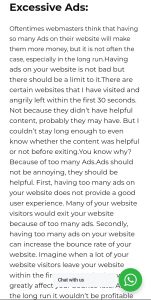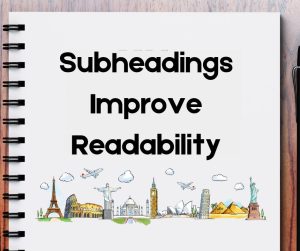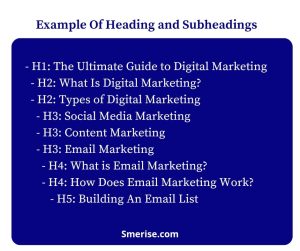“Headings and subheadings are the road signs of your content, guiding readers to where they need to go.” Anonymous
Introduction
Let’s talk about something that might seem a bit basic but is actually super important when writing a blog post—headings and subheadings.
Recently, someone sent me a link to a blog post that I needed for a project I was working on.
The blog post contained information that was crucial for me, but at first, I didn’t realize its importance. When my friend sent me the link, she simply said, “Read this blog post and thank me later.”
To be honest, I wasn’t able to read the blog post initially—it just wasn’t appealing, so I stopped. A week later, she realized I hadn’t read it, so she persuaded me to finish it.
I decided to give it another try since she sounded so convincing. But guess what? The article turned out to be incredibly resourceful and helpful.
However, I wouldn’t have been able to read it to the end if not for my friend’s insistence. Do you know why I struggled to read the article at first? It wasn’t readable!
The article contained valuable information but had poor readability because it was poorly formatted. There were no subheadings, no short paragraphs, and overall, the formatting was just bad.
As a result, it had very low readability.
You know, these little titles and sections that break up your content might seem like small details, but trust me, they make a huge difference.
I’ll be sharing a few tips with you on how to make your blog posts better and have more readability.
Come with me, let’s get right into it.

Why Talk About this?
Google accounts for over 95% of global mobile search engine market share worldwide, according to Statcounter.
This implies that a lot of people all over the world are visiting Google on a daily basis for different search queries. This brings them to different websites, depending on the keywords they used and the websites that rank for them.
So people will always visit your website to read your blog post.
Furthermore, almost 50% of buyers read a company’s blog when making purchase decisions according to Hubspot.
How well are you able to get the most out of them ?
Do people visit your website and bounce out in a short time? Or do they visit your website and stay for a longer time?
These stuff, Headings and Subheadings, that look like minor details have the ability to keep people on your website for a longer time.
That is why it is important to talk about them
What Are Headings and Subheadings?
Before we dive into why they matter, let’s quickly define what we’re talking about.
– Headings are the main titles in your content, the big points you want to get across. They’re usually in a larger, bolder font so they stand out.
– Subheadings are smaller sections that break down your content into more digestible chunks.
Check out these two screenshots below and tell me your observations.


Did you notice that one is more appealing than the other?
Which one is more appealing?
You got it right, the one with headings and subheadings!
That’s the idea
“In the world of blogging, headings and subheadings aren’t just decorations; they’re essential tools for readability and engagement.”
Why Do Headings and Subheadings Matter?
1. They Make Your Content Easier to Read
Okay, imagine that you land on a blog post, and it’s just a giant wall of text. No breaks, no titles—just a sea of words.
What do you do? If you’re like most people, you probably hit the back button faster than you can say “boring.” This is why headings and subheadings are lifesavers.
By breaking up your content, you’re making it way easier for your readers to follow along.
Example: Let’s say you’re writing about “The Benefits of Organic Farming.”
Without headings, it’s like throwing your readers into a jungle. But concerning headings like!
- “Health Benefits of Organic Produce,”
- “Environmental Impact of Organic Farming,”
- “Challenges of Organic Farming.”
You’re giving them a map to navigate through your post.
“A well-placed heading is like a handshake—it introduces your ideas with clarity and confidence.”
2. They Help with SEO (and Who Doesn’t Want That?)
Here’s something that might surprise you—headings and subheadings aren’t just for your readers.
They’re also for search engines like Google. Yep, Google loves it when your content is nicely organized because it makes their job easier.
When you use headings, you’re basically telling Google, “Hey, this is what my post is about,” and that can help you rank higher.
Example: If you’re writing a post on “How to Start a Vegetable Garden,” using headings like “Choosing the Right Location for Your Garden” or “Essential Tools for Gardening” helps Google figure out what your post is all about.
And who knows? Maybe it’ll give you a little boost in the search rankings.
3. They Keep Your Readers Engaged
Let’s be real—attention spans are short these days, especially online. Most people don’t read a blog post word for word; they scan it first.
Headings and subheadings act like signposts, guiding them to the parts they care about most.
If your headings are clear and interesting, you’ll keep them on your page longer, and that’s always a win.
“A great heading grabs attention, but a smart subheading keeps the conversation going.”
4. They Make Your Content Flow Better
Ever read something that jumps around so much you feel like you’re on a rollercoaster? That’s what happens when there’s no logical flow to the content.
Headings and subheadings help you keep things on track, making sure your post flows smoothly from one point to the next.
Example: Let’s say you’re writing a detailed guide on “How to Write a Business Plan.” You might structure it with headings like “Executive Summary,” “Market Analysis,” and “Financial Projections.” Each section builds on the last, making it easier for your readers to follow along.

5. They Make Your Content More Accessible
Here’s something you might not have thought about—headings and subheadings make your content more accessible.
Not everyone reads the same way. Some people use screen readers or other assistive technologies, and having clear headings helps these tools navigate through your content.
How to Use Headings and Subheadings Like a Pro
Now that we’ve covered why headings and subheadings are so important, let’s talk about how to use them effectively.
Here are a few tips to keep in mind:
1. Follow a Logical Structure
Think of your headings as a hierarchy. Your main title is the H1 (the big boss), and your subheadings follow as H2, H3, and so on.
Keeping things in order helps both your readers and search engines understand your content.

2. Keep Them Short and Sweet
When it comes to headings, less is often more. Keep them short, sweet, and to the point. This helps your readers quickly understand what each section is about.
Example: Instead of “The Various Health Benefits of Consuming Organic Vegetables Regularly,” try “Health Benefits of Organic Vegetables.” Short, right?
3. Incorporate Keywords (But Don’t Overdo It)
Including keywords in your headings is a good idea, but make sure they fit naturally. Keyword stuffing is a big no-no—it makes your content awkward and less readable.
Example: If your keyword is “healthy breakfast ideas,” a natural heading might be “Healthy Breakfast Ideas for Busy Mornings” instead of forcing something like “Breakfast Healthy Ideas for Good Health.” See the difference?
4. Make Them Descriptive
Your headings should give readers a clear idea of what they’ll find in each section. The more descriptive, the better!
Example: Instead of a vague heading like “Tips,” go for something like “Time-Saving Tips for Meal Prepping.” Now your readers know exactly what they’re getting.
“Headings give your content structure, while subheadings provide the stepping stones that lead readers through your ideas.”
Watch Out for These Common Mistakes
Even though headings and subheadings are pretty straightforward, there are still some common mistakes to watch out for:
Keyword Overload:
Yes, keywords are important, but don’t go overboard. Keep it natural.
Inconsistent Formatting:
Make sure your headings are consistently formatted. It helps keep your content looking clean and professional.
Summary
So, there you have it—headings and subheadings are more than just fancy titles in your blog posts.
They’re essential tools that improve readability, boost SEO, keep your readers engaged, and help your content flow better.
Plus, they make your posts more accessible to everyone.
Next time you’re working on a blog post, give a little extra love to your headings and subheadings. Trust me, it’s worth it. Your readers—and Google—will thank you!

